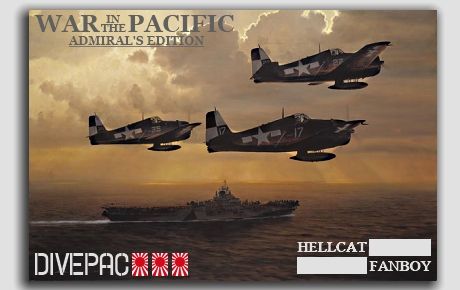AW1Steve
Posts: 14507
Joined: 3/10/2007
From: Mordor Illlinois
Status: offline

|
quote:
ORIGINAL: Dixie
quote:
ORIGINAL: AW1Steve
quote:
ORIGINAL: Dixie
quote:
ORIGINAL: Chickenboy
[holds up hand in embarassed fashion]
I had never seen "The Final Countdown" before last night. It was available on Netflix streaming, so I watched it (in HD!  ) whilest wife unit worked. ) whilest wife unit worked.
A fun flick. Lots of plane porn, particularly Tomcat heavy-not that that's a bad thing. I must say that a 20mm GEC minigun does a real number on A6M2s. Same with an AIM-9.  Would have loved to see what a Nimitz class Alpha strike did against the KB, but alas those damn time portals pick the most inconvenient time to pop up in the plot line. Would have loved to see what a Nimitz class Alpha strike did against the KB, but alas those damn time portals pick the most inconvenient time to pop up in the plot line.
A technical question for you fliers: would the heat sig from an A6M2 at full throttle be sufficient to get a lock from a mid-development AIM-9 series? I know the Ls and beyond are pretty sensitive, but wondering about the early 1980s models so employed in the movie.
Forgot to mention that VF-84 (The Jolly Rogers) was always my favorite VF group. Gotta love the group insignia. 
I've read an account of a SHAR pilot who reckoned that an AIM-9L picked up the heat source from a railway wagon carrying newly rolled steel and a dung heap. Not sure how effective the earlier versions of the 1980s were, I know the RAF carried out some trials with Spitfires as target aircraft in the late 50s where they found out that piston engine aircraft made poor targets for heat-seeking missiles.
A Sidewinder, like any heat seaker, will seek out the hottest signature available. A lot depends on back ground. A Zero over a dung wagon, goodby dung wagon! A Zero against cool sky, goodby Zero. The best way for most maritime based aircraft to elude a heat seeker, is generally dive close to the water and hope that the waters surface layer has absorbed enough sun-light to be warmer than the aircraft trying to elude the missile.
Isrealis pilots developed a technique of climbing for the sun, shutting down the engines, then falling off towards earth , against 1st generation heat seekers.  NOT the way I'd recommend in a combat situation. NOT the way I'd recommend in a combat situation.
The question in my mind is would the Zero survive or even set off the missile, or would it pass through? As I recall, the 9 Limas were pretty state of the art in 1982 . But I also recall the Final countdown to be a late 70's flick.
Surely there's an issue with the heat signatures of a piston powered aircraft vs a jet powered one.
A jet aircraft is propelled by the exhaust gases of its powerplant. To achieve this (and due to the nature of gas turbine engine layouts) the exhaust is at the rear of the aircraft. Thus the 400 degree + gases are released into the atmosphere and are easily tracked. The reason the SHARs managed such success in the Falklands was that the AIM-9L was much better at locking on from difficult angles rather than the traditional dead astern position.
A piston engined aircraft such as the A6M uses an internal combustion engine to drive a propeller at the front of the aircraft. The exhaust gases are (a) cooler and (b) much lower in quantity. Thus you've got a much lower thermal signature to lock onto, a situation made worse by the fact the exhaust gases will be shielded by the wings as well giving the gas more time to dissipate.
The RAF came to the conclusion that the best tactic for a modern fighter (the Lightning at the time, but equally applicable to the F-14) was a gun attack from beneath. Any WW2 aircraft would be unable to match am F-14 as it climbed away.
Of course there maybe a difference, but engine placement also fits in. Is the engine shielded?Obscured? And of course the heat source makes a difference. But as someone who spent 23+ years using FLIR,IRDS and other infrared systems I can tell you that background often makes a much bigger difference than heat source. A human being gives off far less heat than a jet engine. But a human being on a iceflow will give you a better "lockon" than a jet engine directly over a warm Carribean ocean (especially at 200 or less feet). We regularly trained at low level combat maneuvering in such conditions, and often was difficult for a fighter to hold any kind of lock on us, despite four big jet engines on top of the wing. (Yes I know the P-3C is a prop plane, but it's a Turbo-prop....that's a JET powered prop). High reflection on the water, rapidly manevering , SLOW aircraft. If it was hard to get us, imagine trying to hit a far smaller, much more maneverable and partially fabric covered Zero. Especially from a plane that CAN'T fly slow. And Jet pilots don't like to fly near the water. When you firewall the engine, there's a delay that props don't have.
There was the famous "drag race" in P-3 circles where an F-4 and a P-3 , taking off from parallel runways , will reach 1000' at differnet time. "Well, of course you say, everyone knows the jet will reach it 1st". But it won't. The jet has to build up thrust (part of the problem with early jets on carriers) but the prop is nearly instantaneous.
When TOP GUN (the Navy fighter weapons school) was formed ,they would frequently put unsupecting Aviators up against weird combinations. Including WW2 fighters. It was a heck of lot more difficult than the modern jet jock thought, which more than a few found out to his dismay. 
_____________________________
|
 Printable Version
Printable Version








 ) whilest wife unit worked.
) whilest wife unit worked.  Would have loved to see what a Nimitz class Alpha strike did against the KB, but alas those damn time portals pick the most inconvenient time to pop up in the plot line.
Would have loved to see what a Nimitz class Alpha strike did against the KB, but alas those damn time portals pick the most inconvenient time to pop up in the plot line. 


 NOT the way I'd recommend in a combat situation.
NOT the way I'd recommend in a combat situation. 



















 New Messages
New Messages No New Messages
No New Messages Hot Topic w/ New Messages
Hot Topic w/ New Messages Hot Topic w/o New Messages
Hot Topic w/o New Messages Locked w/ New Messages
Locked w/ New Messages Locked w/o New Messages
Locked w/o New Messages Post New Thread
Post New Thread